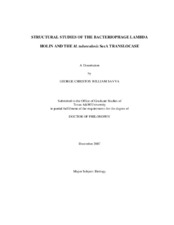| dc.contributor.advisor | Holzenburg, Andreas | |
| dc.creator | Savva, George Christos | |
| dc.date.accessioned | 2010-01-15T00:07:49Z | |
| dc.date.accessioned | 2010-01-16T00:33:04Z | |
| dc.date.available | 2010-01-15T00:07:49Z | |
| dc.date.available | 2010-01-16T00:33:04Z | |
| dc.date.created | 2007-12 | |
| dc.date.issued | 2009-05-15 | |
| dc.identifier.uri | https://hdl.handle.net/1969.1/ETD-TAMU-2438 | |
| dc.description.abstract | Double stranded DNA bacteriophages achieve release of phage progeny by disrupting the cell envelope of the host cell. This is accomplished by two phage-encoded proteins, the holin and the endolysin. In bacteriophage lambda, the S holin is a small three TMD membrane protein that creates a lesion in the inner membrane of the host at a specific time, programmed in its primary structure. Lesion formation permits the cytoplasmic endolysin R access to the murein cell wall for degradation and cell lysis. Although it has been shown that S oligomerizes in the membrane, the structural nature of this complex has not been elucidated. In this study the S holin was purified using a mild non-ionic detergent and the structure of a ring complex formed by the holin was determined by electron microscopy and single particle analysis at a resolution of 2.6 nm. Biochemical characterization of the rings suggests that such a complex might represent the assembly formed by S in the membrane. Protein translocation in all organisms allows the export of proteins destined for localization outside the cytoplasm. In eubacteria, newly synthesized proteins are directed to the heterotrimeric membrane complex SecYEG by signals embedded in their sequence. The driving force through this complex is provided by the cytoplasmic ATPase SecA which combines ATP hydrolysis to mechanically insert proteins through the protein conducting channel. Using electron microscopy and single particle analysis we have obtained the structure of SecA from M. tuberculosis. The structure indicates that four SecA monomers assemble to form an elongated molecule with D2 symmetry. Docking of the EM map to the crystal structure of tb SecA confirms this arrangement of the subunits. This finding, that M. tuberculosis SecA forms a tetramer raises intriguing possibilities about SecA function. | en |
| dc.format.medium | electronic | en |
| dc.format.mimetype | application/pdf | |
| dc.language.iso | en_US | |
| dc.subject | holin | en |
| dc.subject | secA | en |
| dc.subject | electron microscopy | en |
| dc.subject | single particle analysis | en |
| dc.title | Structural studies of the bacteriophage lambda holin and M. tuberculosis secA translocase | en |
| dc.type | Book | en |
| dc.type | Thesis | en |
| thesis.degree.department | Biology | en |
| thesis.degree.discipline | Biology | en |
| thesis.degree.grantor | Texas A&M University | en |
| thesis.degree.name | Doctor of Philosophy | en |
| thesis.degree.level | Doctoral | en |
| dc.contributor.committeeMember | Sacchettini, Jim | |
| dc.contributor.committeeMember | Siegele, Debby | |
| dc.contributor.committeeMember | Young, Ry | |
| dc.type.genre | Electronic Dissertation | en |
| dc.type.material | text | en |
| dc.format.digitalOrigin | born digital | en |


